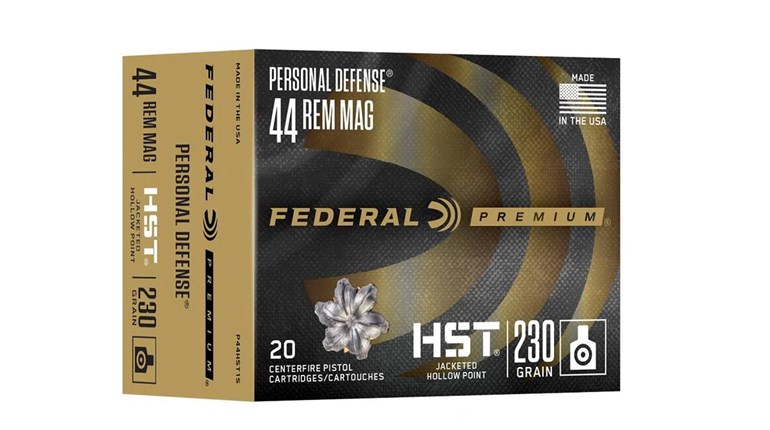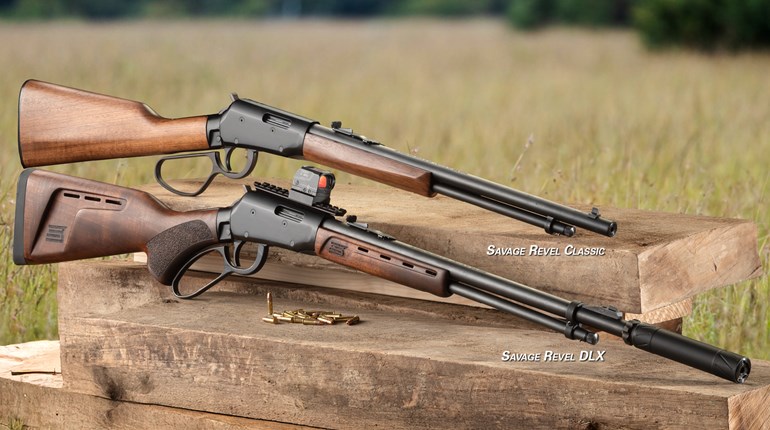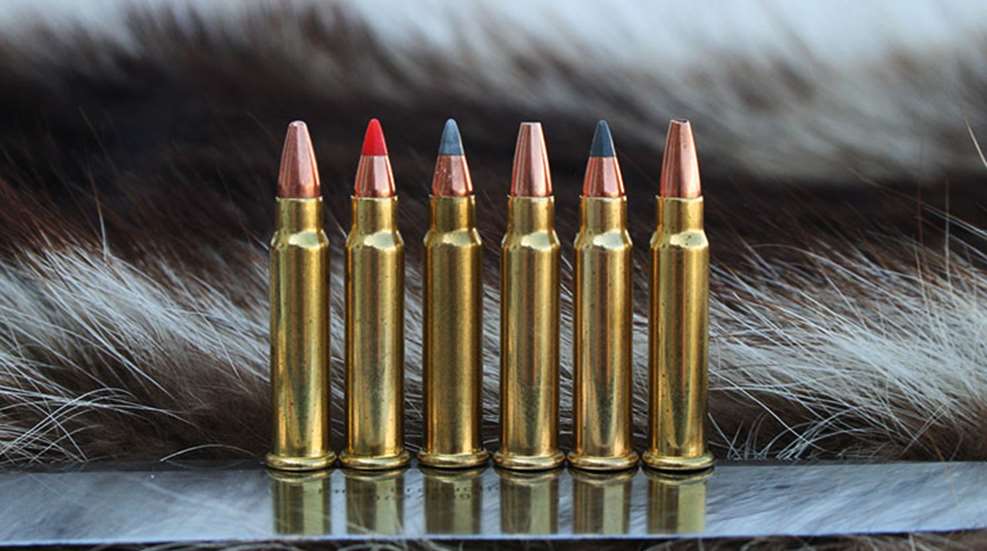
In 2002, the then-new .17 Hornady Magnum Rimfire (HMR) joined a select few cartridges that had absolute epic debuts; in fact, so great was initial interest among shooters that it significantly spoilt sales of the stalwart .22 Winchester Magnum Rimfire (WMR). In the ensuing years, sales of .22 WMR-chambered rifles rebounded to an extent, thanks to advancements in ammunition, but the .17 HMR still remains a proverbial “thorn in its side.”
The .17 HMR’s immediate and sustained success cannot be attributed to hype; even the most well-crafted lie breaks down under scrutiny—especially in the realm of firearms. Rather, the cartridge offered a noteworthy improvement in external ballistics over the .22 WMR. Even today, the only rimfire round that overcomes it is the .17 WSM.
A simple recipe achieves enhanced external ballistics in the .17 HMR: propel lightweight, tiny projectiles fast. Higher velocities translate to flatter trajectories, making hits at distance easier, and with a faster time to target, there’s less wind deflection, too—a real benefit for the petite pests that the .17 HMR is used for. The aforementioned attributes easily increase the effective range of the .17 HMR beyond 200 yards, though stories abound of adept marksmen connecting at 300 yards and further. Splitting those numbers is more realistic for consistent hits.
Speaking of “hits,” when the little, frangible projectiles arrive on target they generally congregate in tight clusters, with each one capable of eye-opening terminal performance on even the smallest species, such as prairie dogs and ground squirrels. Because they’re so fragile, there’s minimal risk of ricochet which, when combined with a modest rifle report, makes the .17 HMR a good option for eradicating pests in more settled areas.
Although there exists overlap between the .17 HMR and .22 WMR, each has its individual strengths. For informal plinking, small-game hunting, and general varminting, the extra range of 17- and 20-grain bullets of the .17 HMR is a godsend. Additionally, ammunition for the .17 HMR is often somewhat cheaper, too; for instance, MidwayUSA lists loads priced from $10.99 to $14.99 per fifty-round package, with the leadless options comprising the latter. There is tremendous load diversity as well. CCI, for example, has seven .17 HMR offerings.
Where does that leave the .22 WMR? It, too, is found in an array of loadings, and the cartridge will certainly handle with aplomb any species that the .17 HMR will; however, it’s a better choice if coyotes are regularly encountered or targeted, as there’s greater bullet mass and it achieves deeper penetration. Don’t get me wrong, with a well-executed shot, the .17 HMR will surely kill the wily “song dog,” but it might escape before expiring—that’s undesirable.
The reality is that there’s ample room in the marketplace and hunting fields for both cartridges. I have evaluated six current .17 HMR hunting loads to ensure you’re loaded optimally for a given pursuit. I describe the essentials of each load, as well as performance with regard to accuracy from a bench rest at 100 yards (five consecutive, five-shot groups), velocity and terminal performance (at 50 yards in modeling clay). Velocities were recorded using a Competition Electronics Digital Chrono chronograph 15 feet from the 21-inch barrel of the test rifle; an older, bull-barrel Savage Model 93R17 topped with a Leupold 8.5X-25X-50mm long-range scope. Bear in mind that as a bolt-action rifle, the Savage was incapable of illustrating functionality of the ammunition in a semi-automatic, .17 HMR-chambered arm, and inherent accuracy shouldn’t be judged solely based on results from a single rifle, either. Lastly, I noted the advantages and drawbacks associated with each load. In no particular order, here are my findings.
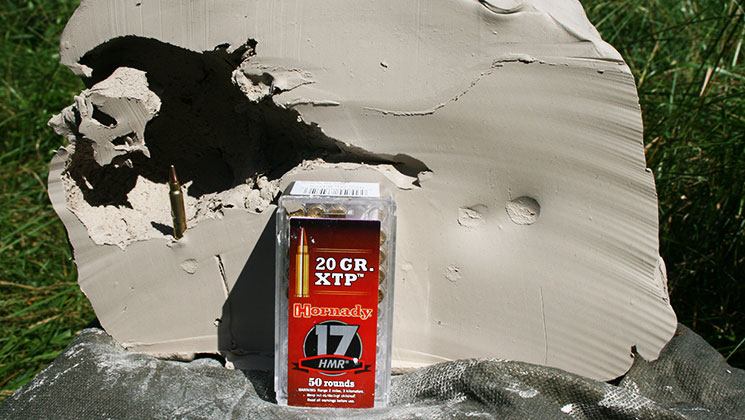
1. Hornady 20-grain HP XTP Varmint Express
• Particulars: This load features Hornady’s 20-grain hollow-point eXtreme Terminal Performance (XTP) bullet propelled to 2375 fps, thereby producing 250 ft.-lbs. of energy at the muzzle. Due to its heaviness and stouter construction, the XTP is better suited for predators (i.e. fox and coyote) than the lighter, tipped projectiles common within this roundup. In reading numerous reviews of ardent users, I discovered that hunters who regularly pit their .17 HMRs against coyotes swear by them. As such, given their ability to consistently take game upward in size of coyotes would make this an excellent all-around option. MSRP: $12.99 per 50-rnd. box; midwayusa.com.
• Test: Across the chronograph at 15 feet, the load averaged 2437 fps—a slight increase over factory specifications. As for accuracy, five consecutive, five-shot groups averaged 0.90″, and the single smallest group was an excellent 0.52″. Hitting small targets at long range shouldn’t be a problem. In the modeling clay, the 20-grain hollow-point bullet penetrated deepest—only slightly—of all bullets tested; yet it also left a tremendous cavity in its wake. In consequence, it would make a great load if hunting where you’re apt to cross paths with coyotes at some point.
• Advantages: Reasonable cost, deepest penetration, large cavitation, accurate
• Drawbacks: None
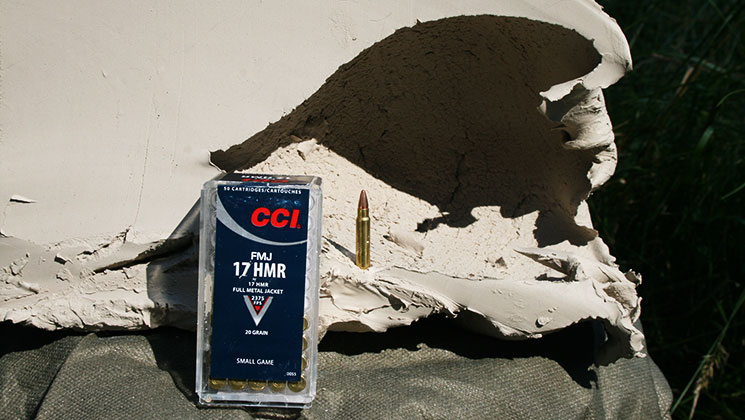
2. CCI 20-grain FMJ
• Particulars: CCI is the only manufacturer that I located offering a full metal jacket (FMJ) load. Marketed as a small-game load (as opposed to varminting), the 20-grain FMJ is rated for 2375 fps and 250 ft.-lbs. of energy at the muzzle. Obviously, the intent of a FMJ is to reduce damage to edible meat and valuable furbearer pelts; I found prodigious numbers of user accounts describing both. Personally, when hunting black bear in Alberta, Canada, I noted that several local “trappers” forwent setting steel traps to secure their take beaver; instead, they floated the river in canoes and utilized this load. The result was generous quantities of the nuisance furbearer with less effort. Some hunters also swear by the load for head-shooting squirrels at distance. MSRP: $11.99 per 50-rnd. box; midwayusa.com.
• Test: According to the chronograph, the CCI 20-grain FMJ load averaged 2439 fps—virtually identical to the 20-grain Hornady load reviewed above. Accuracy-wise, the load did very well, averaging 0.88″ for 25 shots—perfect for precise bullet placement. Head shots on small-game should be simple. As for its performance in modeling clay, this one caught me by surprise. Forget what you know about FMJs; despite reports of tiny holes in hides, the performance in clay was eye-opening. In fact, the bullet created the largest cavity of all loads tested, and it penetrated deeply to boot. That being said, this isn’t the load I’d select to hunt coyotes, as even fairly hit animals are likely to escape.
• Advantages: Eye-opening terminal ballistics, accurate, low cost, no-lead-exposed bullet (at the tip), reports of minimal damage to meat and pelts
• Drawbacks: None
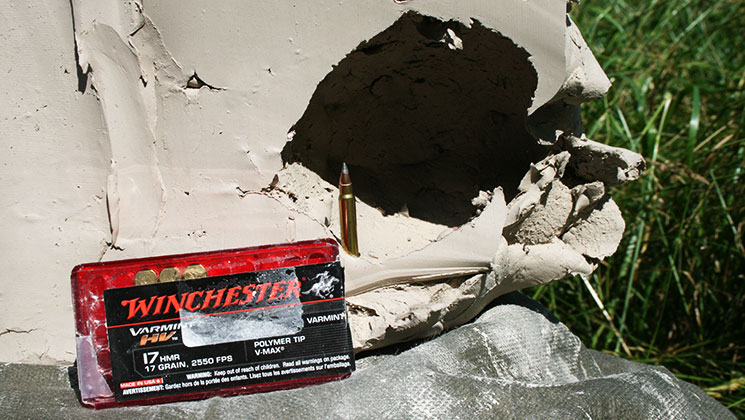
3. Winchester Varmint HV 17-grain V-Max
• Particulars: Among a couple loads in this roundup featuring a Hornady-manufactured 17-grain V-Max bullet (this one has a gray tip), the Winchester Varmint HV propels the highly frangible projectile to 2550 fps, producing 245 ft.-lbs. of energy at the muzzle. Trademarks of Hornady’s 17-grain, 0.172″ V-Max bullet are excellent accuracy and violent expansion, making this a option for varminters looking to stretch the distance on prairie dogs and ground squirrels, not necessarily coyotes. MSRP: $14.29 per 50-rnd. box; basspro.com.
• Test: From the 21″-barreled Savage 93R17, the Varmint HV 17-grain V-Max load averaged 2485 fps—65 fps less the published numbers, which is acceptable. As for accuracy, it was rather disappointing. The average for five consecutive, five-shot groups was 1.39″—the worst of the collection by a considerable margin. What’s more, during testing there were three failures to fire, and subsequent attempts didn’t remedy the situation, either. Unfortunately, from the varied accounts that I read online, this isn’t an isolated event with this particular load. As for terminal performance, the 17-grain V-Max left a sizable cavity in the clay. It would certainly prove extremely effective at dispatching small varmints.
• Advantages: Impressive terminal performance
• Drawbacks: Disappointing accuracy, three failures to fire (out of 50 rounds), difficult to find, costly, less penetration (not the best choice for coyotes but excellent for small varmints)
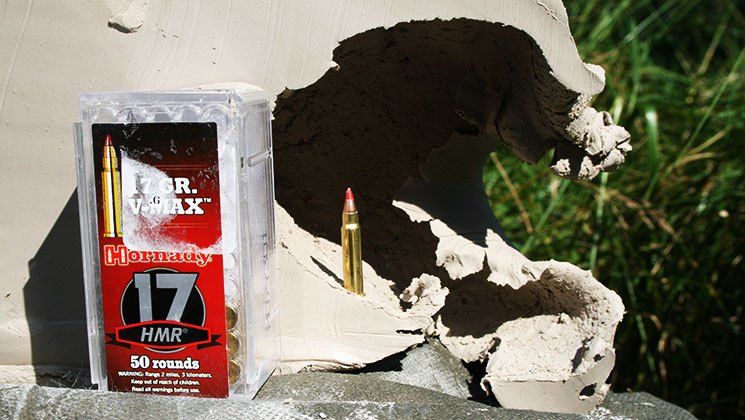
4. Hornady 17-grain V-Max Varmint Express
• Particulars: As with the Winchester load above, this one by Hornady employs its 17-grain V-Max bullet. Propelled to 2550 fps, the petite pill packs a wallop—245 ft.-lbs. of energy at the muzzle. Since it’s the identical projectile, it can be used for the same pursuits, from plinking to varminting at-distance. Again, unless one is restrained and takes only head shots, this is not the load to use on edible game; damage to meat will be considerable. For varmints that’s a non-concern. MSRP: $12.99 per 50-rnd. box; midwayusa.com.
• Test: When testing this load, the chronograph screen read “2568” as the average for five shots—a welcomed slight increase over published data. As for accuracy, the Savage held the 25-shot average to 1.02″, which is adequate for targeting nuisance species at the further realistic ranges of the .17 HMR. Concerning clay cavitation, the V-Max bullet from this load—predictably—created an empty space that mimicked that from the Winchester offering. Therefore, it would work for the same uses.
• Advantages: Oversize cavity in the clay, relatively inexpensive, good accuracy
• Drawbacks: Less penetration (not the best choice for coyotes but excellent for small varmints)
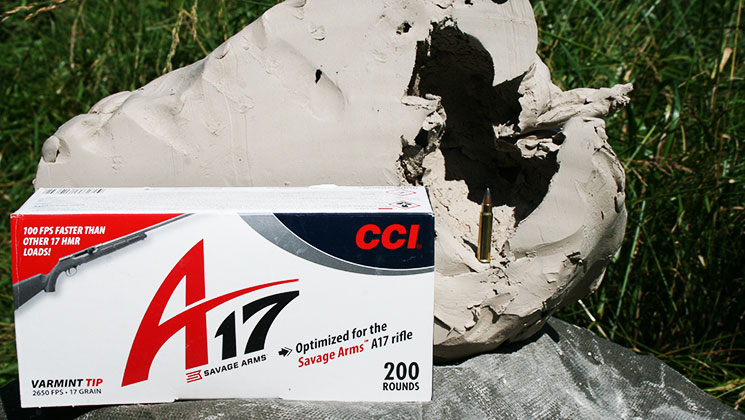
5. CCI A17 17-grain Varmint Tip
• Particulars: Marketed as “optimized for the Savage Arms A17” semi-automatic rifle, the CCI A17 propels a polymer-tipped, 17-grain projectile to 2650 fps—100 fps more than the other .17 HMR rounds. That generates 264 ft.-lbs. of energy at the muzzle. Increased energy is of minimal concern on varmints, but a flatter trajectory and less wind deflection are real benefits at extended range. As with the above V-Max-equipped offerings, this load is best relegated to targets and non-edible species. MSRP: $11.99 per 50-rnd. box; midwayusa.com.
• Test: CCI A17 averaged 2642 fps for five rounds, which is only 8 fps slower than the factory-touted number—pretty remarkable. It was, by far, the fastest of the loads tested, though I experienced one failure to fire, and a restrike couldn’t remedy it, either. Speed is good, but accuracy is needed, too, and the load had a mean of 0.95″. The smallest group ran 0.64″. As for terminal performance, the 17-grain polymer-tipped bullet left a sizable, though very shallow cavity. Still, for small varmints, it’d excel.
• Advantages: Very good accuracy, fastest load tested, inexpensive, flattest trajectory
• Disadvantages: Small cavity in clay (not the best choice for coyotes but excellent for small varmints), one failure to fire (out of 50)
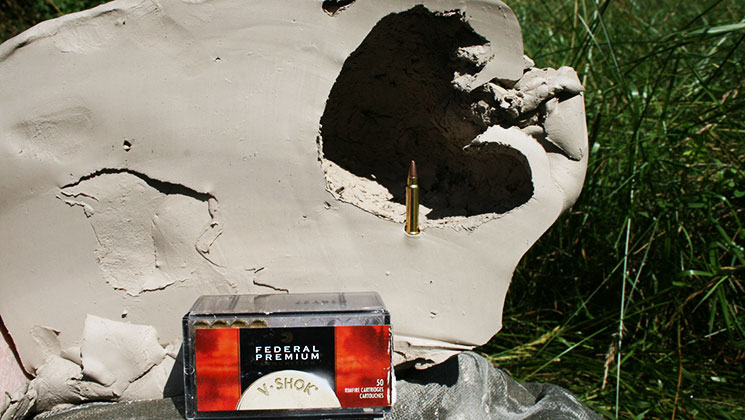
6. Federal Premium V-Shok 17-grain TNT HP
• Particulars: Although the Federal Premium TNT HP is similar in profile to Hornady’s 20-grain HP XTP bullet, at 17 grains it’s obviously not the same projectile. Beyond being lighter, which allows it to attain 2550 fps, it’s also more fragile in construction; it’s designed for rapid fragmentation and thus limited penetration. For that reason, it’d excel on small varmints both near and far. Edible game? Forget it; there’d be little left for the pot. MSRP: $10.99 per 50-rnd. box; sportsmansguide.com.
• Test: The 17-grain TNT HP was a speedster; in fact, at 2615 fps it boasted an average increase of 65 fps over the factory published velocity. Concerning accuracy, at 0.69″ the Federal Premium load produced the smallest overall average by a noteworthy sum. The gun simply preferred it over the others. As for terminal ballistics, the fragile TNT bullet inflicted mayhem on the clay, creating a very large yet shallow cavity. For that reason, it would be a great choice on smaller varmints where depth of penetration is a non-concern. Damage will be extensive and dramatic, so its use on edible game isn’t advisable.
• Advantages: Most accurate load tested, inexpensive, fast
• Drawbacks: Less penetration (not the best choice for coyotes but excellent for small varmints)
The .17 HMR is the dream cartridge for medium-range varminters, small-game hunters and plinkers alike; it offers flat trajectories, indiscernible recoil and terminal performance way out of proportion to its diminutive size. It’s little wonder, then, why it captured the limelight and refuses to let go.
Want to read more from Aaron Carter? Check out the following articles:
• Top 6 .22 WMR Hunting Loads
• Top 6 Subsonic .22 LR Loads for Small-Game Hunting
• Top 7 Deer Bullets for the .308 Win.
• 7 Top-Tier Hunting Bullets for the .243 Win.












